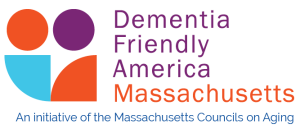Dementia/Age Friendly
What is an Age Friendly Community?
The concept of an age-friendly community embraces the notion that all people in a community can benefit from an environment that supports them as they age in their community. First presented by the World Health Organization (WHO), an age-friendly world enables people of all ages to actively participate in community activities and treats everyone with respect, regardless of their age. It is a place that makes it easy for older people to stay connected to people that are important to them. And it helps people stay healthy and active even at the oldest ages and provides appropriate support to those who can no longer look after themselves. Brookline MA was the first MA city to become recognized as a WHO age-friendly community in the U.S. in 2012.
What is the Difference Between Age Friendly and Dementia Friendly?
Very good question. An age-friendly community helps all older adults feel welcomed, engages people of all ages in community life, helps all older adults remain active and healthy and engages town and civic organizations in making a deliberate commitment to all of the above a reality across the Eight Sectors of an age-friendly environment.
Source: WHO (2019)
This WHO publication explains the age-friendly community movement and its current status in the mobile age. https://www.mobile-age.eu/news/159-new-who-handbook-on-age-friendly-environments.html.
The Massachusetts Health Aging Collaborative (MHAC) helps communities in MA become age-friendly. For more information about MHAC can be found at https://mahealthyagingcollaborative.org/age-friendly/toolkit/.
An age-friendly community can be a dementia-friendly community, but only if it offers specific outreach, training and overall citizen awareness of dementia so that the community can become a welcoming place for people living with dementia, their loved ones’ and their caretakers. Such an initiative requires significant efforts by town and civic leaders, professionals, service staff and citizens to overcome the stigma of dementia and reach out to those people living with the disease to give them a little extra help and compassion.
Your community can be age-friendly but not dementia friendly. And, you can be dementia-friendly community but not really be age-friendly. So how do the two initiatives work together?
Better Together: Dementia and Age-Friendly Communities
AARP joined with WHO to foster the idea of Age-Friendly states and communities as the U.S. partner. More about the AARP Age-Friendly initiative can be found at https://www.aarp.org/livable-communities/network-age-friendly-communities/info-2014/an-introduction.html. Given the wide interest in both initiatives both in MA and across the country, AARP produced a guide to help communities combine the two initiatives.
https://www.aarp.org/livable-communities/network-age-friendly-communities/info-2016/dementia-friendly-communities.html
Where does a Community Begin?
The Massachusetts Executive Office of Elder Affairs, Jewish Family & Children’s Service, and the Tufts Health Plan Foundation convened a summit on May 9, 2016, that brought together leaders from 84 organizations interested in age-friendly and dementia-friendly work. A need identified at the Summit was for an “environmental scan” to look at the work being done on age-friendly and dementia-friendly activities between August 2016 and January 2017.
https://mahealthyagingcollaborative.org/wp-content/uploads/2017/07/DFAF_report_07312017.pdf
